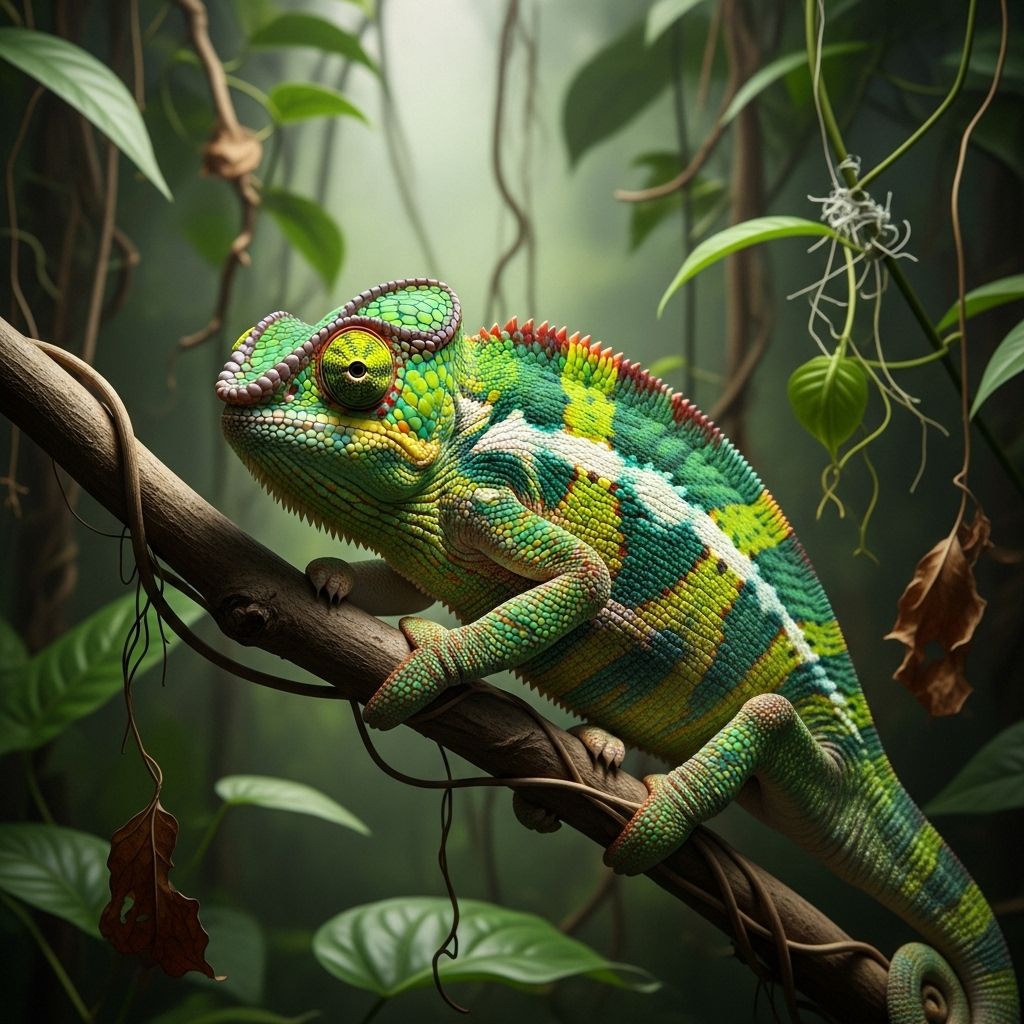Color-Changing Chameleons Face New Survival Threats
Chameleons' famed color-changing ability is no longer enough to protect them from mounting environmental hazards and human pressure.

Known for their uncanny ability to change color in response to their environment, chameleons have long captured the fascination of biologists and wildlife enthusiasts. These reptiles are celebrated not just for their vibrant displays, but for the evolutionary marvels that make their adaptations so extraordinary. Yet despite these seeming advantages, many chameleon species are struggling to keep pace with rapidly changing environmental threats and widespread human impacts. This article delves into the mechanisms of chameleon color change, the limitations of their camouflage in a changing world, and the escalating crises they face—ranging from habitat loss to illegal wildlife trade—and what conservation efforts are underway to protect their future.
The Magic and Limits of Chameleon Color Change
Chameleons are perhaps most famous for their remarkable color-changing abilities. They can shift hue and brightness in a flash, blending into their surroundings or signaling to conspecifics and predators alike. This adaptation involves two main biological mechanisms:
- Pigment Movement: Certain chameleons change their color by shifting pigments within specialized skin cells called chromatophores.
- Structural Color Changes: In addition to pigment, nanocrystals in the skin physically alter how light is scattered, producing brilliant, variable color effects.
Recent research illustrates that the ability to shift color is not uniform across backgrounds. For example, the flap-necked chameleon (Chamaeleo dilepis) quickly adapts to dark backgrounds—such as black—but is slower and less consistent when presented with more vivid or unnatural hues like orange. Against backgrounds closer to their natural habitats, such as blue-green or yellow-green, the chameleons often exhibit little or no change; they instinctively align with what they are already well equipped to match.
Why Do Chameleons Change Color?
- Camouflage from predators: The primary driver is evasion from birds and other predators.
- Communication: Bright displays often signal aggression or readiness to mate.
- Thermoregulation: Some change colors to absorb or reflect heat, assisting in temperature regulation.
While this marvel of evolution has served chameleons well for millions of years, fresh scientific analysis shows that these color-shifting skills have clear limits, especially as environmental conditions become increasingly artificial or unpredictable.
Adaptation under Pressure: Habitat Loss and Fragmentation
Despite their adaptability, chameleons are highly vulnerable to changes in the landscape. The overwhelming threat to most chameleon species today is habitat loss and fragmentation—primarily driven by deforestation, agricultural expansion, and urban sprawl.
- Deforestation: Madagascar, home to nearly half of the world’s chameleon species, has been especially hard hit by the loss of native forest due to timber harvesting and slash-and-burn agriculture.
- Agricultural Expansion: Encroachment of farms into wild habitats destroys both food sources and safe shelter for chameleons.
- Urbanization: The growth of cities and rural settlements further fragments the habitats needed for chameleons’ complex life cycles.
Chameleons often have exceedingly small home ranges or are restricted to single mountaintops or forest patches. This range restriction amplifies their risk: when these localized habitats are lost, entire species can be wiped out in a short span.
Species at Highest Risk
Of the more than 200 recognized chameleon species, fully a third (36%) are threatened with extinction according to the IUCN Red List. Notably:
- Madagascar’s endemic chameleons: 85 species are found nowhere else, including the micro leaf chameleon and the endangered Furcifer minor.
- Range-restricted African chameleons: Specialized species with highly localized habitats across East Africa and the Indian Ocean islands also face acute risks.
Climate Change, Invasive Species, and Other Threats
Habitat loss is not the sole danger to chameleons. A suite of additional stressors compounds the crisis, putting further pressure on already vulnerable populations:
- Climate Change: Shifting weather patterns, increased drought, and rising temperatures are making certain habitats inhospitable. Sudden extreme events can devastate small, isolated populations.
- Invasive Predators: Rats, birds, and mongooses introduced to Madagascar and East African ecosystems prey on chameleons and their eggs, contributing to population crashes.
- Illegal Wildlife Trade: Unsustainable collection for the pet trade targets exotic and rare species and can eradicate wild populations if not strictly controlled.
- Pesticide Use: Increased agriculture often brings chemical pesticides, which may poison not only insects but also the chameleons that consume them directly or indirectly.
These threats do not act in isolation—a chameleon species faced with habitat loss is even more vulnerable if added climate stress or invasive species pressure is present. With so many chameleons occurring only in a single habitat patch, even a localized event can be catastrophic.
Chameleons’ Role in Their Ecosystems
Chameleons are not just charismatic; they are integral to the healthy function of their ecosystems. Their presence helps regulate insect populations, which, if unchecked, could harm native plants or crops. They also contribute to pollination dynamics and serve as prey for higher predators, anchoring various ecological webs.
- Insect Control: Chameleons are voracious carnivores, specializing in catching insects with their long, sticky tongues.
- Tourism’s Symbol: In Madagascar, chameleons are a marquee attraction for eco-tourism, supporting local economies and emphasizing the importance of wild conservation areas.
Conservation Efforts: Protecting a Disappearing Wonder
Recognizing the diversity and peril of chameleon species, a wide array of conservation initiatives have emerged, ranging from protected area management to public education:
- Reserve and National Park Designation: Securing and managing habitats in places such as Madagascar’s Lokobe National Park to provide sanctuaries for the rarest chameleons.
- Local Community Involvement: Collaborative conservation efforts that empower local populations to monitor and protect chameleon habitats, often through eco-tourism and education programs.
- Captive Breeding Programs: Some at-risk species are successfully bred in captivity for future reintroduction or as assurance colonies, often supported by global zoos.
- Research and Monitoring: Ongoing scientific research aims to better understand chameleon biology, identify population trends, and test potential interventions.
- International Trade Regulation: Enforcement of CITES and national laws helps combat illegal trafficking in wild chameleons for pets and curios.
Success Stories and Ongoing Challenges
Efforts in regions like Madagascar show positive results, especially when local communities are involved and ecotourism incentives align with conservation goals. However, funding and resources remain limited. Ongoing education and advocacy are vital to highlight the unique beauty and ecological function of these creatures, ensuring that they are prioritized not just by scientists but by wider society too.
Limits of Adaptation: Why Chameleons Can’t Keep Up With Change
A recurring theme in scientific studies is that chameleons’ adaptive abilities—however dazzling—may not be sufficient to withstand the current pace and scale of environmental change. Though evolutionary pressures once equipped them with versatile camouflage, even the swiftest flap-necked chameleons are challenged by backgrounds and pressures for which their biology has not prepared them.
Furthermore, studies simulating predator vision indicate that when environments are altered—through introduced invasive plants, artificial materials, or abrupt human changes—traditional camouflage often fails. Chameleons may instinctively prefer habitats matching their historic patterns, but fragments and rapid change frequently leave them exposed or unable to find suitable refuge.
Can Chameleons Adapt Fast Enough?
- Evolutionary adaptation is a slow process—one that may not outpace the urgent timeline of habitat loss and climate disruption.
- Conservation biologists warn that unless direct action is taken to secure critical habitats and reduce human pressures, many species may vanish long before their color-shifting abilities might have a chance to further evolve.
Table: Snapshot of Chameleon Crisis
| Threat | Impact on Chameleons | Mitigation Strategies |
|---|---|---|
| Deforestation | Destroys habitat; isolates populations | Protected areas, reforestation |
| Climate Change | Temperature and rainfall shifts; extreme events | Climate-adaptive management, monitoring |
| Invasive Species | Predation on eggs, juveniles, and adults | Control programs; habitat restoration |
| Illegal Trade | Overharvesting, population decline | International regulation, certification |
Frequently Asked Questions (FAQs)
Q: How do chameleons change color?
A: Chameleons change color using specialized skin cells called chromatophores (which contain pigments) and iridophores (which use structures to reflect light). By altering both pigment concentration and structural alignment at a microscopic level, they produce rapid and dramatic color changes.
Q: Is color change only for camouflage?
A: No. While camouflage is a primary function, color changes in chameleons also play significant roles in communication (such as dominance displays or signaling reproductive status) and thermoregulation (adjusting color to manage body heat).
Q: What is the biggest threat to chameleons today?
A: The single biggest threat is habitat destruction due to human activities—deforestation and land conversion for agriculture are major drivers. Climate change, invasive species, and illegal trade intensify the crisis.
Q: Which chameleon species are most at risk?
A: Many of Madagascar’s endemic species (found nowhere else) are at critical risk. Species with very small, isolated ranges are the most vulnerable, with several already listed as Endangered or Critically Endangered.
Q: What can be done to protect chameleons?
A: Primary actions include protecting natural habitat, enforcing anti-poaching and anti-trafficking laws, supporting research, breeding and reintroduction programs, and increasing public awareness about their ecological importance.
How Can You Help?
- Support conservation organizations dedicated to habitat protection in Madagascar and Africa.
- Avoid purchasing wild-caught chameleons or exotic pets lacking certification from legal breeding programs.
- Spread awareness about the importance of biodiversity and sustainable land use.
- Participate in or support eco-tourism operations that empower local communities and prioritize conservation.
Conclusion
The chameleon’s evolutionary artistry—its iconic color change—remains a marvel, but survival now depends as much on human intervention as natural selection. If we value a world where these captivating reptiles continue to exist, urgent and sustained efforts across conservation, policy, and community action are essential. Only then can chameleons and the rich web of life they support endure in our rapidly changing world.
References
- https://www.gvi.co.uk/blog/smb-exploring-the-unique-chameleons-of-madagascar/
- https://news.exeter.ac.uk/faculty-of-environment-science-and-economy/camouflaging-chameleons-look-better-in-black/
- https://news.mongabay.com/2014/11/chameleon-crisis-extinction-threatens-36-of-worlds-chameleons/
- https://chameleons101.com/chameleon-crisis-understanding-and-combating-the-extinction-threat-to-the-worlds-chameleons/
- https://blogs.iu.edu/sciu/2021/07/10/chameleons-color/
- https://pmc.ncbi.nlm.nih.gov/articles/PMC2674084/
- https://www.ripleys.com/stories/chameleons-change-color
Read full bio of medha deb












